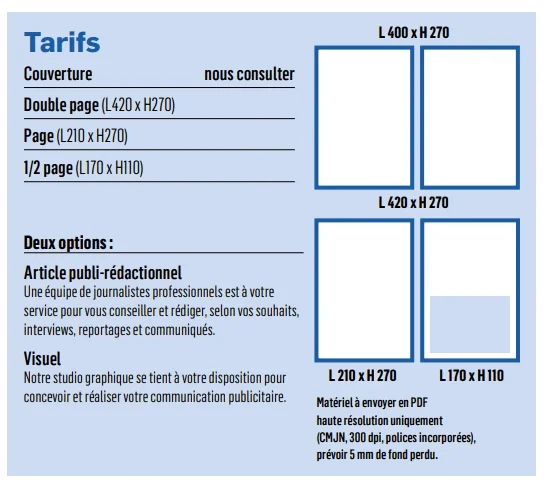Space not available
Reserve this advertising space
Selected ad format
The file format is not recognized
Click here for
upload an ad
Click here to download
an announcement
Here drag and drop or
upload an ad
Send the ad up to 8 days after payment
A link will be sent to you by contact@via-agency.media
Reserved space
Announcement transmitted
Reference
– Artisanal fishing and industrial production

Thanks to its coastline of over 400 kilometers, industrial production and artisanal fishing are estimated at 365 tons and 60 tons respectively. Fishing and aquaculture are two areas of development.
Space not available
Reserve this advertising space
Selected ad format
The file format is not recognized
Click here for
upload an ad
Click here to download
an announcement
Here drag and drop or
upload an ad
Send the ad up to 8 days after payment
A link will be sent to you by contact@via-agency.media
Reserved space
Announcement transmitted
Reference
With a deficit production of nearly 20,000 tonnes of fish per year, this sector records unrecorded losses of more than 40% of catches, thrown back into the sea due to their low market value, and nearly 20 tonnes in informal export.
Cameroon imports several tons of frozen fish each year to satisfy its local consumption, estimated at 500,000 tons per year, compared to a national production estimated at 340,000 tons. In 2021, the country imported 189.5 million tons of fish, for a budget estimated at 134.1 billion. To reverse its dependence on imports, the government plans to increase aquaculture production from 32,000 to 50,000 tons in 2025 and from 70,000 to 100,000 tons in 2030. In Cameroon, most industrial fishing vessels are owned by foreign companies operating under a joint venture, in which a national partner handles administrative matters.
Space not available
Reserve this advertising space
Selected ad format
The file format is not recognized
Click here for
upload an ad
Click here to download
an announcement
Here drag and drop or
upload an ad
Send the ad up to 8 days after payment
A link will be sent to you by contact@via-agency.media
Reserved space
Announcement transmitted
Reference

Congelcam, an import company, controls the entire frozen fish distribution chain in Cameroon from start to finish. It is a key partner of the government in supplying the market with fish and combating the high cost of living. Fish and rice are the two main food products imported by Cameroon.
Also, the aquaculture entrepreneurship development support program, part of the implementation of Snd30, aims to develop fish production across the entire national territory and in all the techniques of the current sector agreement. This important project is expected to start in 2023 and end in 2029. If the conditions are met, production could thus triple, or even quadruple, the end result being that fewer products are imported, and that, as a result, Cameroonians increasingly consume local production.
According to FAO data, shrimp is now Cameroon's main seafood export. This trade employs approximately 1,500 people. The government's main expectation following the implementation of the Fish4ACP project, initiated by the Organization of African, Caribbean and Pacific States (OACPS), is to see Cameroonian shrimp return to the European market, from which it has been banned since 2004. To achieve this, Fish4ACP, implemented in Cameroon by the FAO with funding of 13 billion CFA francs from the EU and the German Federal Ministry for Cooperation, aims to deploy actions primarily aimed at strengthening businesses and the regulatory environment. This will involve analyzing the value chain to help its stakeholders exploit the potential of maritime fisheries; supporting small and medium-sized enterprises (SMEs) to meet domestic demand and access high-value export markets; create new jobs and improve working conditions by strengthening the business and regulatory environment; improve the environmental sustainability of the value chain through better stock management and reduced bycatch; and facilitate access to other sources of finance and investment. Shrimp exporters had turned to Asia, which now captures the bulk of exports.
The social, economic, and environmental consequences of illegal, unreported, and unregulated (IUU) fishing are significant. In March 2022, FAO facilitated a workshop to develop a national strategy and action plan to eliminate IUU fishing in Cameroon.
OPPORTUNITIES
According to Article 122 of the 2022 General Tax Code, companies engaged in agriculture, livestock farming and fishing benefit from various tax advantages, including exemption from tax and employer charges on salaries paid to seasonal workers by individual operators; exemption from registration fees for transfers of land allocated to fishing; exemption from registration fees for loan agreements intended to finance fishing activities; exemption from property tax on properties belonging to fishing companies and allocated to these activities, excluding buildings used as offices; exemption from VAT on the purchase of fishing inputs, equipment and materials, etc.
Space not available
Reserve this advertising space
Selected ad format
The file format is not recognized
Click here for
upload an ad
Click here to download
an announcement
Here drag and drop or
upload an ad
Send the ad up to 8 days after payment
A link will be sent to you by contact@via-agency.media
Reserved space
Announcement transmitted
Reference

















 A Seat That Transforms into a Bed
A Seat That Transforms into a Bed  In the world of air travel, economy class is often considered the most affordable option. However, at Air Afrika, we believe that affordability shouldn't mean compromising on quality of service. Our class
In the world of air travel, economy class is often considered the most affordable option. However, at Air Afrika, we believe that affordability shouldn't mean compromising on quality of service. Our class









